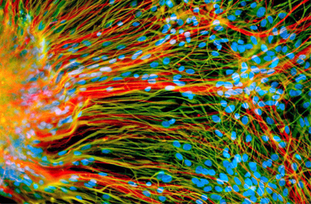Mapping the cellular origin and early evolution of leukemia in Down syndrome. (Science 2021) Children with Down syndrome have a 150-fold increased risk of developing myeloid leukemia, but the mechanism of predisposition is unclear. Because Down syndrome leukemogenesis initiates during fetal development, we characterized the cellular and developmental context of preleukemic initiation and leukemic progression using gene editing in human disomic and trisomic fetal hematopoietic cells and xenotransplantation.
Sphingosine-1-Phosphate Receptor 3 Potentiates Inflammatory Programs in Normal and Leukemia Stem Cells to Promote Differentiation. (Cancer Discovery 2021) Acute myeloid leukemia (AML) is a caricature of normal hematopoiesis driven from leukemia stem cells (LSC) that share some hematopoietic stem cell (HSC) programs including responsiveness to inflammatory signaling. Although inflammation dysregulates mature myeloid cells and influences stemness programs and lineage determination in HSCs by activating stress myelopoiesis, such roles in LSCs are poorly understood. Here, we show that S1PR3, a receptor for the bioactive lipid sphingosine-1-phosphate, is a central regulator that drives myeloid differentiation and activates inflammatory programs in both HSCs and LSCs. S1PR3-mediated inflammatory signatures varied in a continuum from primitive to mature myeloid states across cohorts of patients with AML, each with distinct phenotypic and clinical properties.
A latent subset of human hematopoietic stem cells resists regenerative stress to preserve stemness. (Nature Immunology 2021) Continuous supply of immune cells throughout life relies on the delicate balance in the hematopoietic stem cell (HSC) pool between long-term maintenance and meeting the demands of both normal blood production and unexpected stress conditions. Here we identified distinct subsets of human long-term (LT)-HSCs that responded differently to regeneration-mediated stress: an immune checkpoint ligand CD112lo subset that exhibited a transient engraftment restraint (termed latency) before contributing to hematopoietic reconstitution and a primed CD112hi subset that responded rapidly.
The Transition from Quiescent to Activated States in Human Hematopoietic Stem Cells Is Governed by Dynamic 3D Genome Reorganization. (Cell Stem Cell 2021) Lifelong blood production requires long-term hematopoietic stem cells (LT-HSCs), marked by stemness states involving quiescence and self-renewal, to transition into activated short-term HSCs (ST-HSCs) with reduced stemness. As few transcriptional changes underlie this transition, we used single-cell and bulk assay for transposase-accessible chromatin sequencing (ATAC-seq) on human HSCs and hematopoietic stem and progenitor cell (HSPC) subsets to uncover chromatin accessibility signatures, one including LT-HSCs (LT/HSPC signature) and another excluding LT-HSCs (activated HSPC [Act/HSPC] signature). These signatures inversely correlated during early hematopoietic commitment and differentiation.
CC-90009, a novel cereblon E3 ligase modulator, targets acute myeloid leukemia blasts and leukemia stem cells. (Blood 2021) A number of clinically validated drugs have been developed by repurposing the CUL4-DDB1-CRBN-RBX1 (CRL4CRBN) E3 ubiquitin ligase complex with molecular glue degraders to eliminate disease-driving proteins. Here, we present the identification of a first-in-class GSPT1-selective cereblon E3 ligase modulator, CC-90009. Biochemical, structural, and molecular characterization demonstrates that CC-90009 coopts the CRL4CRBN to selectively target GSPT1 for ubiquitination and proteasomal degradation. Depletion of GSPT1 by CC-90009 rapidly induces acute myeloid leukemia (AML) apoptosis, reducing leukemia engraftment and leukemia stem cells (LSCs) in large-scale primary patient xenografting of 35 independent AML samples, including those with adverse risk features. Using a genome-wide CRISPR-Cas9 screen for effectors of CC-90009 response, we uncovered the ILF2 and ILF3 heterodimeric complex as a novel regulator of cereblon expression. Knockout of ILF2/ILF3 decreases the production of full-length cereblon protein via modulating CRBN messenger RNA alternative splicing, leading to diminished response to CC-90009.
Dr. John Dick on his famous discovery of cancer stem cells, and the puzzle of research (UHN Behind the Breakthrough Podcast, 2020) In this episode, Dr. John Dick takes us behind the scenes on his career, building on the pioneering work of Drs. James Till and Ernest McCulloch—the first to define the properties of stem cells. He delves into the pivotal moments that led to discoveries that have changed the face of cancer research, and why science doesn’t happen in a vacuum.
Relapse-Fated Latent Diagnosis Subclones in Acute B Lineage Leukemia Are Drug Tolerant and Possess Distinct Metabolic Programs. (Cancer Discovery 2020) Disease recurrence causes significant mortality in B-progenitor acute lymphoblastic leukemia (B-ALL). Genomic analysis of matched diagnosis and relapse samples shows relapse often arising from minor diagnosis subclones. However, why therapy eradicates some subclones while others survive and progress to relapse remains obscure. Elucidation of mechanisms underlying these differing fates requires functional analysis of isolated subclones. Here, large-scale limiting dilution xenografting of diagnosis and relapse samples, combined with targeted sequencing, identified and isolated minor diagnosis subclones that initiate an evolutionary trajectory toward relapse [termed diagnosis Relapse Initiating clones (dRI)].
Sphingolipid Modulation Activates Proteostasis Programs to Govern Human Hematopoietic Stem Cell Self-Renewal. (Cell Stem Cell, 2019) Cellular stress responses serve as crucial decision points balancing persistence or culling of hematopoietic stem cells (HSCs) for lifelong blood production. Although strong stressors cull HSCs, the linkage between stress programs and self-renewal properties that underlie human HSC maintenance remains unknown, particularly at quiescence exit when HSCs must also dynamically shift metabolic state. Here, we demonstrate distinct wiring of the sphingolipidome across the human hematopoietic hierarchy and find that genetic or pharmacologic modulation of the sphingolipid enzyme DEGS1 regulates lineage differentiation.
Functional profiling of single CRISPR/Cas9-edited human long-term hematopoietic stem cells. (Nature Communications, 2019) In the human hematopoietic system, rare self-renewing multipotent long-term hematopoietic stem cells (LT-HSCs) are responsible for the lifelong production of mature blood cells and are the rational target for clinical regenerative therapies. However, the heterogeneity in the hematopoietic stem cell compartment and variable outcomes of CRISPR/Cas9 editing make functional interrogation of rare LT-HSCs challenging. Here, we report high efficiency LT-HSC editing at single-cell resolution using electroporation of modified synthetic gRNAs and Cas9 protein.
A stemness screen reveals C3orf54/INKA1 as a promoter of human leukemia stem cell latency (Blood 2019) There is a growing body of evidence that the molecular properties of leukemia stem cells (LSCs) are associated with clinical outcomes in acute myeloid leukemia (AML), and LSCs have been linked to therapy failure and relapse. Thus, a better understanding of the molecular mechanisms that contribute to the persistence and regenerative potential of LSCs is expected to result in the development of more effective therapies. We therefore interrogated functionally validated data sets of LSC-specific genes together with their known protein interactors and selected 64 candidates for a competitive in vivo gain-of-function screen to identify genes that enhanced stemness in human cord blood hematopoietic stem and progenitor cells.
Prediction of acute myeloid leukaemia risk in healthy individuals (Nature 2018) The incidence of acute myeloid leukaemia (AML) increases with age and mortality exceeds 90% when diagnosed after age 65. Most cases arise without any detectable early symptoms and patients usually present with the acute complications of bone marrow failure. The onset of such de novo AML cases is typically preceded by the accumulation of somatic mutations in preleukaemic haematopoietic stem and progenitor cells (HSPCs) that undergo clonal expansion. However, recurrent AML mutations also accumulate in HSPCs during ageing of healthy individuals who do not develop AML, a phenomenon referred to as age-related clonal haematopoiesis (ARCH). Here we use deep sequencing to analyse genes that are recurrently mutated in AML to distinguish between individuals who have a high risk of developing AML and those with benign ARCH.
Tracing the origins of relapse in acute myeloid leukaemia to stem cells (Nature 2017) In acute myeloid leukaemia, long-term survival is poor as most patients relapse despite achieving remission. Historically, the failure of therapy has been thought to be due to mutations that produce drug resistance, possibly arising as a consequence of the mutagenic properties of chemotherapy drugs. However, other lines of evidence have pointed to the pre-existence of drug-resistant cells. Here, through combined genetic and functional analysis of purified subpopulations and xenografts from paired diagnosis/relapse samples, we identify therapy-resistant cells already present at diagnosis and two major patterns of relapse.

